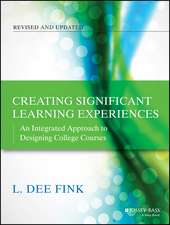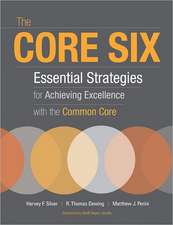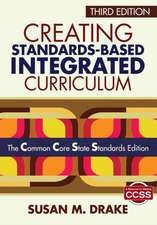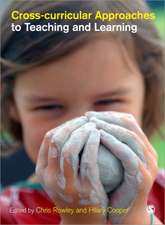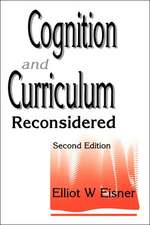Designing Instruction: Making Best Practices Work in Standards-Based Classrooms
Autor Judith K. March, Karen H. Petersen Limba Engleză Paperback – 4 dec 2007
Preț: 371.31 lei
Nou
Puncte Express: 557
Preț estimativ în valută:
71.05€ • 74.52$ • 59.15£
71.05€ • 74.52$ • 59.15£
Carte tipărită la comandă
Livrare economică 01-15 aprilie
Preluare comenzi: 021 569.72.76
Specificații
ISBN-13: 9781412938853
ISBN-10: 1412938856
Pagini: 352
Dimensiuni: 216 x 279 x 21 mm
Greutate: 0.97 kg
Ediția:1
Editura: SAGE Publications
Colecția Corwin
Locul publicării:Thousand Oaks, United States
ISBN-10: 1412938856
Pagini: 352
Dimensiuni: 216 x 279 x 21 mm
Greutate: 0.97 kg
Ediția:1
Editura: SAGE Publications
Colecția Corwin
Locul publicării:Thousand Oaks, United States
Recenzii
"Exceptionally useful, well-organized, and supported by research."
"A fresh new approach that offers creative thinking strategies for administrative leadership teams. Few textbooks have such detailed examples combined with the background study of best practices. The authors have great credibility, experience, resources, and abundant research to support their proposal. A very well-written text offering ample review of the research."
"We used the Designing Instruction process to redefine our entire curriculum and instructional program, and our student achievement has shown steady improvement!"
"The Designing Instruction process helped us focus our efforts on effective teaching practices and the overall improvement of our entire delivery system. We have dramatically improved our pedagogy and the learning outcomes of our students."
"Through the Designing Instruction process, our district empowered teachers to design a standards-based curriculum, develop yearlong curriculum maps, and devise unit plans that integrate best practice teaching and testing methods into every classroom, and our principals have become the stewards who facilitate and sustain the process!"
"What a godsend! Our teachers developed a K-12 standards-based curriculum in math and language arts, and teams of teachers developed course tools that were based on best practice research to deliver our new curriculum in every classroom. As our test scores began to go up, the gap between sub-groups began to narrow. We are thrilled with our success, and the district has continued the process ever since."
"My highest priority was for schoolwide reform that would improve daily classroom instruction—a comprehensive program that would assist teachers in their choice of curriculum, their efforts to differentiate, and their choice of teaching-learning strategies. What we've accomplished using the Designing Instruction program has been outstanding!"
"An invaluable, practical guide for teachers and administrators and education libraries at the college level."
"The authors outline instructional design within the context of school reform. By presenting the material in an accessible way, the book combines theory with practical applications."
"A fresh new approach that offers creative thinking strategies for administrative leadership teams. Few textbooks have such detailed examples combined with the background study of best practices. The authors have great credibility, experience, resources, and abundant research to support their proposal. A very well-written text offering ample review of the research."
"We used the Designing Instruction process to redefine our entire curriculum and instructional program, and our student achievement has shown steady improvement!"
"The Designing Instruction process helped us focus our efforts on effective teaching practices and the overall improvement of our entire delivery system. We have dramatically improved our pedagogy and the learning outcomes of our students."
"Through the Designing Instruction process, our district empowered teachers to design a standards-based curriculum, develop yearlong curriculum maps, and devise unit plans that integrate best practice teaching and testing methods into every classroom, and our principals have become the stewards who facilitate and sustain the process!"
"What a godsend! Our teachers developed a K-12 standards-based curriculum in math and language arts, and teams of teachers developed course tools that were based on best practice research to deliver our new curriculum in every classroom. As our test scores began to go up, the gap between sub-groups began to narrow. We are thrilled with our success, and the district has continued the process ever since."
"My highest priority was for schoolwide reform that would improve daily classroom instruction—a comprehensive program that would assist teachers in their choice of curriculum, their efforts to differentiate, and their choice of teaching-learning strategies. What we've accomplished using the Designing Instruction program has been outstanding!"
"An invaluable, practical guide for teachers and administrators and education libraries at the college level."
"The authors outline instructional design within the context of school reform. By presenting the material in an accessible way, the book combines theory with practical applications."
Cuprins
Acknowledgments
About the Authors
Introduction
Our Journey Through School Reform
Enter Instructional Design
The Purpose for This Book
The Five Parts
Who Should Buy This Book
Part I. School Reform Is All About What Happens in the Classroom
1. Instructional Design as the Catalyst for Successful School Reform
The Eight Core Elements of Successful School Reform
How Does Instructional Design Integrate With Successful School Reform?
Three-Year Time Frame
2. Performance Indicators: The Passkey to Standards-Based Curriculum
What's in the Name?
The Criteria for Valid Performance Indicators
How the Standards Are Organized
Not Classroom Ready, but That's Okay
Using Standards to Strengthen the Learning Culture and Increase Expectations
The Process of Developing Performance Indicators
Frequently Asked Questions and Related Issues
What to Do During the Pilot of Performance Indicators
"Are We There Yet?"
Summary
Part II. Planning
3. Curriculum Mapping
Not a New Concept
Features and Physical Layout of the Curriculum Map
The Instructional Design Aproach to Curriculum Mapping
Teacher-Administrator Accountability
Frequently Asked Questions About the Curriculum Mapping Process
Ensuring a Successful Rollout of the Curriculum Maps
The Three-Year Time Frame
4. Unit Planning: Rationale and Format
Introduction
The Unit Plan Format for Instructional Design
Considerations in Developing Unit Plans
Frequently Asked Questions About Unit Plans
The Three-Year Time Frame
Part III. Best Practices in Unit Planning and Delivery
5. Unit Planning: Motivation and Information
Introduction
Motivation
Information
Bloom's Taxonomy
Summary
6. Unit Planning: Learning Constructs
Introduction
Organizational Patterns
Writing Summary
Note Taking
Math-Problem Analysis and Problem Solving
Vocabulary and Context Clues
Graphic Organizers
Levels of Questioning
Similarities and Differences
Summary
7. Unit Planning: Delivery Strategies
Introduction
Lecture or Explanation
Demonstration
Guided Discussion
Inquiry, or Formulating and Testing Hypotheses
Learning Circles
Socratic Seminar
Action Research
Advance Organizer
Summary
Part IV. Assessment
8. Unit Planning: Assessment and Culmination
Introduction
Assessment
Culmination
Summary
Part V. Capacity-Building
9. Capacity-Building to Integrate Classroom Reform Into the Deep Culture of Each School
Introduction
Benchmarking
How the Data Should Be Used by Teachers and Administrators
Building Leadership Teams
Administrative Stewardship
Collaborative Observations
Summary
Appendix A: Ohio Summary of Results
Appendix B: River Bend Local Schools
Appendix C: Various Methods to Determine Mastery of Performance Indicators
Selcted References
Index
About the Authors
Introduction
Our Journey Through School Reform
Enter Instructional Design
The Purpose for This Book
The Five Parts
Who Should Buy This Book
Part I. School Reform Is All About What Happens in the Classroom
1. Instructional Design as the Catalyst for Successful School Reform
The Eight Core Elements of Successful School Reform
How Does Instructional Design Integrate With Successful School Reform?
Three-Year Time Frame
2. Performance Indicators: The Passkey to Standards-Based Curriculum
What's in the Name?
The Criteria for Valid Performance Indicators
How the Standards Are Organized
Not Classroom Ready, but That's Okay
Using Standards to Strengthen the Learning Culture and Increase Expectations
The Process of Developing Performance Indicators
Frequently Asked Questions and Related Issues
What to Do During the Pilot of Performance Indicators
"Are We There Yet?"
Summary
Part II. Planning
3. Curriculum Mapping
Not a New Concept
Features and Physical Layout of the Curriculum Map
The Instructional Design Aproach to Curriculum Mapping
Teacher-Administrator Accountability
Frequently Asked Questions About the Curriculum Mapping Process
Ensuring a Successful Rollout of the Curriculum Maps
The Three-Year Time Frame
4. Unit Planning: Rationale and Format
Introduction
The Unit Plan Format for Instructional Design
Considerations in Developing Unit Plans
Frequently Asked Questions About Unit Plans
The Three-Year Time Frame
Part III. Best Practices in Unit Planning and Delivery
5. Unit Planning: Motivation and Information
Introduction
Motivation
Information
Bloom's Taxonomy
Summary
6. Unit Planning: Learning Constructs
Introduction
Organizational Patterns
Writing Summary
Note Taking
Math-Problem Analysis and Problem Solving
Vocabulary and Context Clues
Graphic Organizers
Levels of Questioning
Similarities and Differences
Summary
7. Unit Planning: Delivery Strategies
Introduction
Lecture or Explanation
Demonstration
Guided Discussion
Inquiry, or Formulating and Testing Hypotheses
Learning Circles
Socratic Seminar
Action Research
Advance Organizer
Summary
Part IV. Assessment
8. Unit Planning: Assessment and Culmination
Introduction
Assessment
Culmination
Summary
Part V. Capacity-Building
9. Capacity-Building to Integrate Classroom Reform Into the Deep Culture of Each School
Introduction
Benchmarking
How the Data Should Be Used by Teachers and Administrators
Building Leadership Teams
Administrative Stewardship
Collaborative Observations
Summary
Appendix A: Ohio Summary of Results
Appendix B: River Bend Local Schools
Appendix C: Various Methods to Determine Mastery of Performance Indicators
Selcted References
Index
Descriere
Demonstrates how to develop a standards-based curriculum, deliver and assess instruction with research-based best practices, and implement capacity-building processes that support a school's daily operation.








